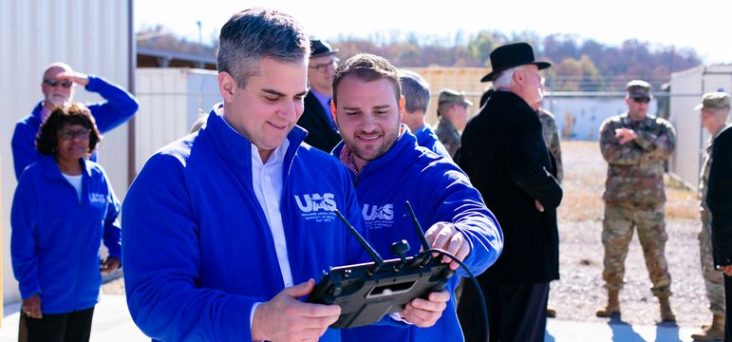UAFS, National Guard partner on drone program at Fort Chaffee
by December 6, 2018 4:52 pm 1,023 views

(Left) Dr. Edward Serna, interim chancellor at UAFS, operates an unmanned aircraft with the help of David Pollman, director of unmanned aerial systems, at Fort Chaffee range Nov. 15.
The University of Arkansas at Fort Smith and the Arkansas National Guard will partner to take the university’s unmanned aerial systems program to the next level.
“The agreement will allow UAFS to use ranges and training areas at Fort Chaffee for students to fly unmanned aircraft, better known as drones. In return, students will perform applied learning exercises that will provide data to Fort Chaffee to assist their environmental and natural resources program,” a media release from the university said.
The partnership will create a “symbiotic recruiting relationship between the two,” said David Pollman, director of unmanned aerial systems at UAFS.
“One of our targets for this degree is the military and veteran community, and partnering with the National Guard allows us to tap into those populations while showing a way they can transition from active duty military to a civilian,” Pollman said. “At the same time, units operating at Fort Chaffee will be able to engage our students and potentially recruit them to the military.”
Students will be able to use ranges at Fort Chaffee as a safe place to operate the aircraft in restricted airspace, Pollman said. Students will have to comply with Federal Aviation Administration (FAA) restrictions, but they will have a clear, unpopulated area to learn, which will alleviate some risk, he added.
In return for the use of space, the Guard will have the benefit of research the students are able to conduct, Pollman said.
“We talked about many ways we might be able to help them. They have a large feral hog population they track (at Fort Chaffee). The students will be able to use this as an exercise, to track the population for them,” Pollman said.
Another way the students will be able to help the Guard pertains to repair that needs to be done to ranges following training exercises.
“They have to go in, take in equipment, and make repairs after these exercises. They need to know where to go and how they can repair those ranges. (Students) will be able to collect imagery and direct resources, showing them where they need to go. It makes it much more efficient than them just sending someone to drive around,” Pollman said.
UAFS students will also help the Guard with environmental regulations.
“One example of this could be controlled burns,” Pollman said. “We could scout and provide data of where they need those.”
THE PROGRAM’S FOCUS
Dr. Edward Serna, interim chancellor at UAFS, was a driving force behind the development of the unmanned aerial systems (UAS) program at the university when he served as the UAFS vice chancellor for strategic development.
Serna said the partnership is a crucial advancement for the program.
“When we first discussed the possibility of an unmanned aerial systems program, we knew we had to do it right if we wanted it to be the national level program that we envisioned,” Serna said. “This partnership is one of the many steps we’re taking to ‘do it right.’ This collaboration will create recruiting pathways for both agencies while providing real-world learning opportunities for our students.”
UAFS has 12 students enrolled in the UAS program this fall. The program offers two associates degrees: AAS-Unmanned Aerial Systems-Operations and AAS-Unmanned Aerial Systems-Analyst.
The first program trains for operating unmanned aerial systems prepares students for the FAA Part 107, often referred to as the drone pilot test, Pollman said. Anyone wanting to pilot a drone for profit must have this license, he said. Recreational drone pilots do not need to be licensed, but must follow FAA guidelines and register their drone, he added.
The second program concentrates on analysis, geographic information system (GIS) and mapping.
“It focuses on output analysis and using the drones as a tool for things like utility inspection and other areas. It is about collecting and processing information,” Pollman said.
Unlike many UAS programs offered at universities across the country that are designed mostly for research use, the UAFS program was designed specifically for workforce development, Pollman said.
In a study by the Association for Unmanned Vehicles Systems International, the unmanned aircrafts systems industry is forecast to create more than 600 jobs and nearly $500 million in economic impact in Arkansas in the next 10 years, according to the school.
“We are preparing our students to be able to leave and go to work in the industry for an organization, business or themselves,” Pollman said.
The university and Pollman are involved in a large recruiting campaign at agencies, like the Army National Guard, and high schools and through military outreach to active duty and veteran military personal in order to boost the programs enrollment for next fall, said John Post, UAFS director of public information. The partnership with the Arkansas National Guard is expected to begin in fall 2019.
